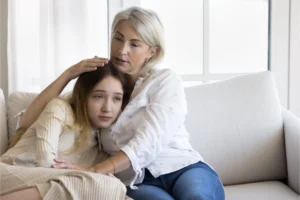
Help for Grandparents Caring for Children In Crisis
Grandparents sometimes have to provide safe and loving homes for grandchildren when their children, the parents of those little ones, are unable to do so.

Learn how to stay connected with your grandkids as they grow — whether they live across the street or around the world
Estimated reading time: 7 minutes
My granddaughter Ophelia rummaged through the toy bin and held up two tattered superhero capes.
“You wear the pink one,” she instructed me and tried to place the cape over my T-shirt. I scooped the tiny 2-year-old into my arms, knowing what came next.
She asked, “Should we dance or fly-a-sky, Grandma?”
I was already scrolling through the playlist on my phone in search of the Mary Poppins song “Let’s Go Fly a Kite.”
Within seconds, Ophie was squealing as we twirled around the room. Dancing—a generous term for my awkward movements—is one way I have connected with my youngest grandchild.
Research by Oxford professor Ann Buchanan indicates that a high level of grandparent involvement, whatever the activity, greatly increases the overall well-being of grandchildren. In a study of more than 1,500 children, Buchanan found that kids who have more involved grandparents have fewer emotional and behavioral problems than kids who don’t have a regular connection.
So how can grandparents ensure a meaningful connection when they’re with their grandchildren? There’s no special grandparent glue, but we can choose to study our grandchildren, ask questions and be intentional about spending time with them.
Each child is uniquely created in God’s image. Therefore, it’s important to watch for his emerging interests, talents and personality traits. You also can observe whether your grandchild is an extrovert or an introvert, a leader or a supporter. Finally, you can take note of his temperament.
Look, also, for signs of how your grandchild expresses love to you and other family members. Does she enjoy spending time with you? Does she always want to bring you a gift? Does she like helping out in the kitchen or snuggling on the sofa with a book? These observations from Dr. Gary Chapman’s research on love languages can give you ideas about how your grandchild is more likely to experience your love when you are together.
The goal of studying your grandchild is to find a way to connect that is meaningful to the child. The better we understand our grand-blessings, the stronger the connection.
When we interact with our grandkids, we should strive to ask questions that reveal their heart. Nurture open-ended conversation instead of yes-or-no questions. Showing an interest in our grandkids as individuals helps create a safe place for them to ask questions in return. These meaningful conversations are where genuine mentoring often takes place.
Opportunity for connection with our grandkids increases when we have one-on-one time with them, rather than engaging with multiple children at once. But if you have more grand-blessings than days in the week, and it isn’t possible to spend time with each child individually, go ahead and do activities in a group. But find moments to engage with each grandchild so he knows you see him as an individual.
Kids with supportive grandparents are far more likely to overcome adversity and become successful in school and life, says school psychologist Karyn Singley Blair, who has spent 20 years working with children and adolescents. Blair identifies five stages of development for children. Understanding these stages will help grandparents better relate to their grandchildren.
During the first year and a half of life, connection with a child is built mainly through physical contact and meeting their primary needs so they develop trust in you, Blair says. Holding, feeding, reading to and playing with kids this age builds familiarity and trust. Even at this early stage, grandparents can study temperaments and emerging personalities. Most children up to 18 months have a very limited vocabulary but will still voice their preferences when asked questions such as “Do you want Grandpa to read Green Eggs and Ham or Good Good Father ?” or “Would you rather color a picture or kick the soccer ball?” Their answers will begin to reveal their unique personalities.
At these ages, grandchildren will desire to do things themselves but will still need a lot of assistance. Establish a bond through helping them develop new skills. We learn a great deal about our grandchildren by patiently allowing them to work alongside us in simple tasks such as cooking, cleaning, doing yardwork and drying dishes.
And keep noticing what makes your grandchildren unique! Are they detail-oriented or big-picture? Do they lose interest easily, or can they follow directions for a while?
When Lisa Hebbert noticed that her 2-year-old granddaughter loved to make messes, she began creating mud pies with her. They later moved into the kitchen, where they exchanged mud for pudding and began creating real desserts together. Today, her granddaughter is a confident cook, and the two of them enjoy watching cooking shows together.
Preschoolers love to play, and they also start to imitate their caregivers. Since laughter connects the generations, be silly together. Allow plenty of playtime, but also pay attention to what a child struggles with and what he is eager to learn. Ask how he feels when he’s learning things.
When my granddaughter Caeris was 3, she became frustrated because she couldn’t catch a Frisbee, and she told me this made her sad.
I purchased some Frisbee rings and we practiced, celebrating each catch with a silly victory dance. Now, at 5, she loves to play Frisbee, and it has become one of our connections as we talk about not giving up just because something is hard.
School-age children are ready to learn how to be good citizens and become part of a bigger community. Connection at this stage happens as a child starts to discover the world outside of his or her family.
Hebbert and her granddaughter found common ground in looking for ways to bless others—whether creating May Day baskets to hang on neighbors’ doorknobs or earning money for a charity. Hebbert built this connection as she recognized her granddaughter’s generous heart and has helped her serve the community around her.
This connection comes from understanding the child, and it may not always be a hobby or interest of your own. My 6-year-old grandson is developing a real love for drawing. He constantly asks my husband and me to show him how to draw things. On my list of favorite things to do, I place drawing right above cleaning the bathroom. But to enter his world and create a bond through something he enjoys, I’ve begun viewing drawing tutorials with him.
Whether I’m sitting with him and helping with the tutorial or drawing alongside him, we are building a connection. That connection gives me the opportunity to talk about being OK with making mistakes and encourage him to turn his mistakes into something even better. Mentoring is easier when we can use an area of our grandchild’s interest to nurture life lessons.
As a grandparent, you know that a teen is looking to find his or her own identity and independence. Your grandchild may begin to pull away from family. Friends may become more important.
To build and maintain connection during this stage, be present but not pushy. Get to know your grandchild’s friends and teammates. Ask your grandchild about his dreams, values and beliefs. Building connection means entering your grandchild’s world rather than forcing him into yours.
Although bonding is easier when a grandparent is physically present, meaningful connection with a grandchild can still happen over long distances. Tina Knowles and her husband, Jim, are new grandparents. “I think distance grandparenting will be the story of our lives,” Tina admits.
She already uses FaceTime to read books to her grandson so her voice becomes familiar to him. They use an app called Tinybeans, which allows their daughters to share photos of the growing grandkids every day.
Notice what your grandchildren are interested in and form a long-distance club related to that area of interest. For Nancy Casterline, it has been a book club. She sends books to her grandchildren, and after she and the kids read each book, they discuss what they’ve read. This can also
be done with kids’ magazines.
Other grandparent clubs might focus on puzzles, kid-friendly recipes, exercise, Scripture memorization or drawing. You could also try a “word of the month” club, where participants can do anything creative with the month’s word, such as drawing, writing or painting.
The point is to create common experiences. Here are other ideas that grandparents have used to connect with long-distance grandkids:
• Call individual grandchildren regularly.
• Offer to have the grandchildren visit you.
• Play online games together.
• Create videos to send to each other.